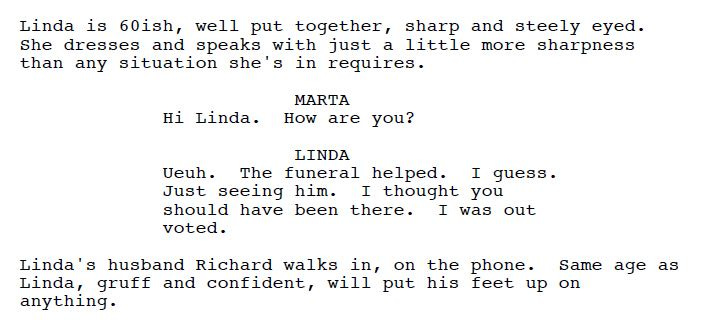Knives Out (2019) Script Review | #49 WGA 101 Greatest Scripts of the 21st Century
Rian Johnson updates the whodunnit genre for 21st century America with a clever and delightful mystery.
Logline: When renowned crime novelist Harlan Thrombey is found dead at his estate just after his 85th birthday, the inquisitive and debonair detective Benoit Blanc is mysteriously enlisted to investigate. From Harlan’s dysfunctional family to his devoted staff, Blanc sifts through a web of red herrings and self-serving lies to uncover the truth behind Harlan’s untimely death.
Written by: Rian Johnson
Pages: 124
With Knives Out, Rian Johnson has accomplished the near-impossible: He’s brought the whodunit story into the 21st century, and made it fun along the way. Spry, fiendishly clever, and a wry commentary on wealth and privilege in Trump’s America (at the time it was written), here is a screenplay that even Agatha Christie would approve.
The mystery: Renowned crime novelist Harlan Thrombey is found dead on the morning after his 85th birthday. Initially ruled as a suicide, the case is reopened at the request by private detective, Benoit Blanc, at the behest of an unknown client. Armed with nothing but his clever methods and a charming slight Southern accent, Blanc works to identify which dysfunctional Thrombey family member had the strongest motive to kill the old man:
Richard, the son-in-law, caught cheating on his wife and Harlan’s daughter, Linda;
Joni, the daughter-in-law, caught embezzling funds from the money that Harlan paid for his granddaughter’s tuition;
Walt, the son, fired from Harlan’s publishing company in order to let him do something of his own;
Ransom, the grandson, the black sheep of the family and the closest in personality to Harlan.
Initially, the script proceeds along the lines you’d expect. Each member of the family is introduced in a way that makes them stand out along with their own memorable quirks…
… and the night before the crime is described to Blanc and depicted, amusingly, in flashbacks where Linda and Walt each think their side of the family is the closest to Harlan…
All of this takes place in Act One, easing us into the world of the Thrombey estate and the family, until Johnson pulls the rug from under our feet to show us what really happened on the night of the crime and the person responsible for the Thrombey patriarch: Marta Carbrera, Harlan’s nurse!
Alfred Hitchcock once said that relying on one big surprise weakened the whodunit’s narrative, and he wasn’t wrong. For instance, Christie’s Hercule Poirot novels tend to essentially be a series of interviews and investigations, with a second murder occurring halfway, before the Belgian detective summons the suspects together to point out the killer. A novel can get away with it, but a film cannot; or more truthfully, it would be a dull affair. Johnson kept Hitchcock’s comments in mind while working on Knives Out, and decided that he’d start the script as a traditional whodunit before turning the middle section into a thriller and reverting to a whodunit towards the close. The thriller section would create enough misdirection for the audience, enliven the narrative, and also create a strong challenge: Reveal the guilty party and then get the audience to root for her not to get caught!
For Marta Cabrera is the only likeable character on the estate— and she’s the protagonist. What happened on the night of Harlan’s death is that Marta accidentally gave the old man the wrong medicine… but Harlan committed suicide in order to erase suspicion from Marta! The old man was very fond of his nurse, who was the only person who did not treat him like a bank account. The fondness is mutual, and the fact that Johnson is able to convey this in one big scene—the death scene—and in brief flashbacks is a testament to his abilities as a writer and filmmaker.
Suddenly, the story switches gears. Despite Harlan’s best attempts, Blanc’s nosing around forces Marta to desperately stay ahead of the detective as well as the police, between pages 34 to 100—the entirety of Act Two, essentially. In this way, Johnson is also able to sustain momentum and tension, to the point you almost forget that this is a whodunit. Perhaps it was a suicide after all.
But no, that would be cheating. And it is at the Midpoint that the murderer, Hugh ‘Ransom’ Drysdale, enters the story after hovering around the periphery until then. Coinciding with the reveal that Harlan rewrote his will and left everything to Marta, Ransom ‘teams up’ with the confused nurse to help— but he really only wants her arrested and out of the way. There’s also a second murder, similar to the Poirot novels, to protect the killer’s identity. It is only after this that the script eases back into whodunit-mode, with Blanc deducing— with an amusing comparison to a donut—the real culprit, who turns out to also be Blanc’s mystery client. Admittedly, the trope of the killer hiring the detective in the first place has appeared in other stories before, but it is put to good effect here.
Johnson came up with the basic concept for Knives Out as early as 2005, shortly after the release of his debut film, Brick. He was planning to turn it into his fourth feature film after making Looper (there is an old interview where Johnson mentions his plans to work on an Agatha Christie type of story) but pushed it aside to work on Star Wars: Episode VIII – The Last Jedi. The delay worked in his favor. By allowing the story to marinate for over a decade, he was able to add in political layers that were previously missing and work on getting the Blanc character right. To create a detective worthy of Poirot and Sherlock Holmes instead of a parody, Johnson threw out all the quirks and eccentricities he’d originally given the character and started with Blanc’s dramatic purpose.
Johnson grew up loving mystery fiction, especially the Christie novels, and puzzles. His attraction to the material is visible in Brick (inspired by Dashiell Hammett) and Looper (essentially a time-travel mystery). But how do you make the private detective work in the 21st century?
Although we see Christie’s work— as the Kenneth Branagh film adaptations especially do— as period pieces, Johnson understood that Christie’s novels were contemporary. Whether it was set in a country house, a train, a cruise liner, or even the desert, Christie was commenting on the state of affairs in her time— dabbling in topical and political issues of her time. One can very well trace the history of 20th century England from the Poirot novels, from World War 1 in The Mysterious Affair at Styles to a post-empire England in the final novel, Curtain.
Additionally, the clever detective is never the human center of these stories. Instead, the detective acts as an observer to the characters on the stage—generally the upper classes— who are dealing with their own troubles of love, financial, or family troubles. Sometimes, it’s even all three! Why them? Because these stories tended to offer a peek into the high crust of society, a world that Christie was very familiar with.
The story, then, really belongs to a protagonist who is not the detective; who has his or her own personal goals to achieve while the mystery gets solved by the detective. Thus, the protagonist of Knives Out is Marta. Hers is the emotional journey we latch on to, while Blanc is there to solve the mystery. Johnson, understanding precisely what makes a whodunit tick, was able to replicate the genre to cinema— bonus points for successfully transporting the story from England to America. Especially considering that friends were initially skeptical that it could work.
Once he’d assembled the pieces, Johnson wrote the screenplay during a six-to-seven–month period in 2018, writing for 8 hours a day while listening to LCD Soundsystem’s Sound of Silver album on loop (it’s a thing for him). I assume he was presumably holed up in his favorite Airbnb rental as he tends to do when he writes a script. As for the clever title, Johnson acknowledges taking the title from a Radiohead song off their 2001 album, Amnesiac.
Blending plenty of humor and writing in a quick, evocative style, the Knives Out screenplay ends up being both a throwback to the whodunit and simultaneously modern and refreshing. Johnson’s passion project paid off both at the box-office and an Oscar nomination for Best Original Screenplay. Together with his producer, Ram Bergman, the world of Knives Out was fleshed out for at least two sequels in a stunning $400-million deal with Netflix (the first sequel, Glass Onion: A Knives Out Mystery, scored an Oscar nomination for Best Adapted Screenplay; at the time of writing, filming for the third installment, Wake Up Dead Man, is underway). It doesn’t take a detective to realize that when you’re with Benoit Blanc, you’re bound to have a good time solving mysteries.
Notes:
Jarvey, Natalie (18 November, 2019) | Making of ‘Knives Out’: How Rian Johnson Assembled a Star-Studded “Jigsaw Puzzle” (The Hollywood Reporter)
Canfield, David (26 November, 2019) | How Rian Johnson wrote Knives Out, the best cinematic whodunit in years (Entertainment Weekly)
Sternbergh, Adam (11 November, 2019) | Knives Out Will Kill You (Vulture)







